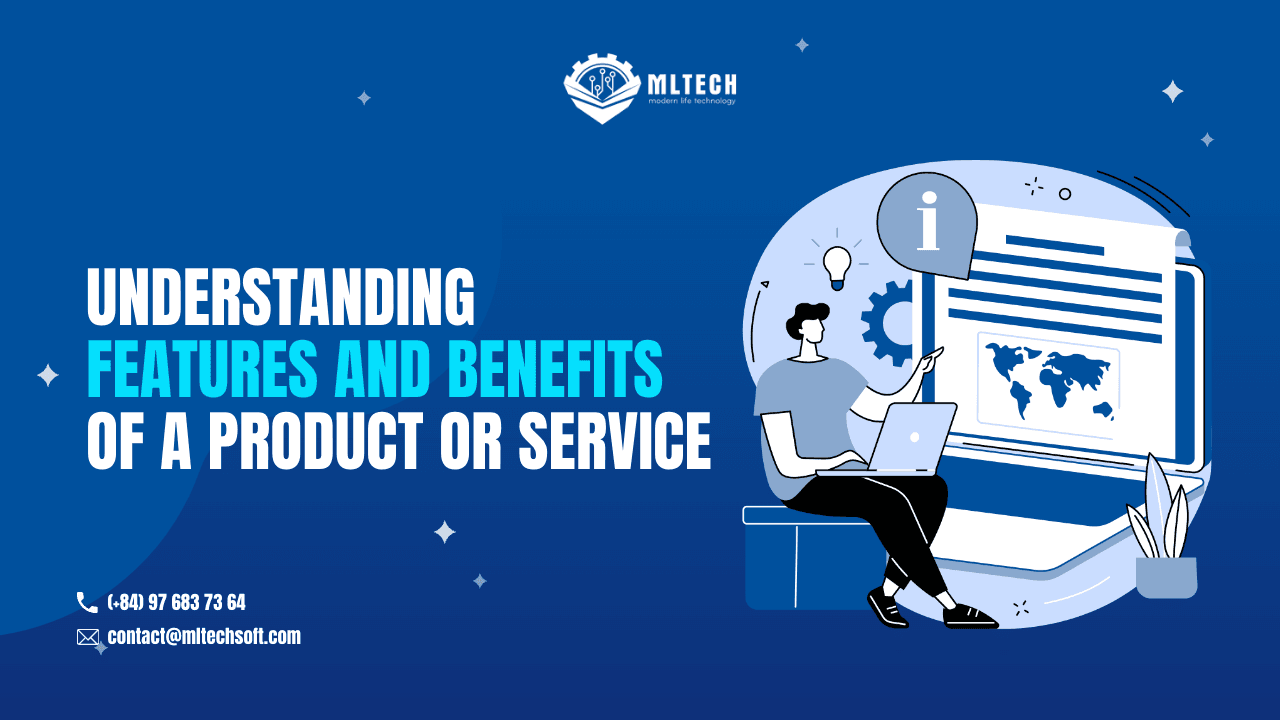Scroll down for more
Understanding Features and Benefits of a Product or Service

According to a study by Marketing Sherpa, 64% of customers are more likely to make a purchase if a product has clearly listed benefits.
A survey by Hubspot found that 73% of customers care about the customer experience when making a purchase. In a study by McKinsey & Company, companies that prioritize customer satisfaction outperform their competitors by 20% in terms of revenue growth. So why should we understand the features and benefits of a product or service?
In this article, we will explore the importance of understanding the features and benefits of a product or service, how to identify and communicate benefits, and how to match product or service benefits to customer needs.
1. Features
1.1. Definition of features
Features typically refer to specific functionalities or capabilities of software, applications, or technology products. Features are the specific components that provide a particular function or service to the user.
In a software application, features may include the ability to import and export data, create custom reports, and send notifications. In a hardware device, features may include the ability to connect to a network, display high-resolution images, or support touch-based interactions.
Features are often a key consideration for IT professionals when evaluating different software or technology solutions. They are evaluated based on how well they meet specific requirements or needs of the organization or users, as well as how user-friendly they are and how well they integrate with other systems.

1.2. Examples of product or service features
These are just a few examples, but there are countless product or service features that can be offered to provide a unique value proposition to customers.
Cloud storage service: Automatic backup and synchronization, Remote access to files, Collaboration and sharing features, Encryption and security features, Multiple device support.
Email service: Email filters and spam protection, Contact management, Calendar integration, Task management, Mobile app access.
Antivirus software: Real-time scanning and protection, Firewall protection, Malware removal, Email protection, Automatic updates.
Video conferencing software: Audio and video conferencing, Screen sharing and collaboration, Chat and messaging, Recording and playback, Background blur.
Project management software: Task management, Gantt charts, Resource management, Time tracking, Collaboration and communication features.
Customer relationship management (CRM) software: Lead management, Sales automation, Contact management, Marketing automation, Reporting and analytics.

Operating system: User interface and experience, Multitasking and window management, File management, Device driver support, Security and privacy features.
1.3. How features differentiate products or services In the highly competitive world of technology, having unique and useful features can make a significant difference in capturing market share and building customer loyalty. Here are a few ways that features can differentiate products or services Functionality: A cloud storage service with a more advanced file-sharing feature may be more attractive to businesses that require extensive collaboration, whereas a simpler service may be more suitable for individual users.
User experience: An email service with an intuitive interface, easy-to-use features, and customizable settings may be preferred over a service with a confusing interface and limited customization options.
Integration: A project management software that integrates with popular communication tools like Slack or Microsoft Teams may be more appealing to businesses that rely on those tools.
Security and privacy: An antivirus software with advanced malware detection and removal features may be more attractive to businesses that prioritize data protection.
2. Benefits
2.1. Definition of benefits
The benefits of a product or service refer to the positive outcomes or advantages that users can experience from using the product or service. Benefits can be both tangible and intangible and can vary depending on the specific product or service.
For example, the benefits of a cloud-based storage service might include cost savings, easy access to data from anywhere with an internet connection, and improved collaboration among team members.
Similarly, the benefits of a project management software might include increased productivity, better organization of tasks, and improved communication among team members.
Ultimately, the benefits of a product or service should align with the needs and goals of the target market and be effectively communicated to potential customers to help them make an informed decision about whether or not to use the product or service.
2.2. Examples of product or service benefits
Cloud computing: This allows businesses to access computing resources such as servers, storage, and applications on demand, reducing the need for costly hardware and software investments.
Customer Relationship Management (CRM) software helps businesses manage customer interactions, track sales leads, and improve customer retention.
Enterprise Resource Planning (ERP) software provides a centralized platform for managing various business functions, such as accounting, inventory, human resources, and supply chain management.

Cybersecurity solutions: They help protect businesses from cyber threats, such as malware, phishing attacks, and data breaches.
Business intelligence (BI) and analytics software: These tools help businesses analyze data to identify trends, make informed decisions, and optimize business processes.
Virtual Private Networks (VPNs): Allow businesses to securely connect remote employees to their corporate network, ensuring data privacy and security.
Website development and design services: These services help businesses create an online presence and engage with customers through their website.
Mobile application development: This allows businesses to reach customers on-the-go through mobile apps, providing convenience and accessibility.
Help desk and technical support services: This section provides businesses with expert technical support and troubleshooting to ensure smooth and efficient operations.
Digital marketing services: They help businesses reach customers through digital channels such as social media, email marketing, and search engine optimization, increasing brand visibility and customer engagement.
2.3. How do benefits meet customer needs?
The benefits of IT products or services can help businesses deliver more efficiently and effectively, increase security, improve collaboration, provide real-time data and analytics, offer scalability and mobility, and ultimately enhance customer satisfaction.
To meet these customer needs, businesses can establish trust and build long-lasting relationships with their customers. When customers feel their needs are being met through the benefits of a product or service, they are more likely to return to that business for future purchases and recommend it to others.
Therefore, it is essential for businesses to understand their customers' needs and tailor their products or services to provide the benefits that meet those needs.
3. Features vs Benefits
3.1. Why are benefits more important than features?
Benefits are more important than features because they focus on what the product or service can do for the customer rather than just listing its technical specifications.
Features describe the physical or technical attributes of a product, while benefits explain how those features provide value to the customer. Customers are not necessarily interested in all the features of a product; instead, they want to know how those features will benefit them. By emphasizing the benefits, businesses can better connect with their customers and demonstrate how their product or service can solve their problems or fulfill their needs.
Benefits can also help businesses differentiate their product or service from their competitors, as they communicate the unique value that they provide. In summary, while features are important to understand the capabilities of a product, benefits are ultimately what persuade customers to purchase and remain loyal to a product or service.
3.2. How to identify and communicate benefits?
Identifying and communicating benefits is crucial to effectively marketing and selling products or services. Here are some steps businesses can take to identify and communicate benefits to their customers:
Understand the customer's needs: The first step is to understand the needs of the customer. This can be achieved by conducting market research, analyzing customer feedback, and observing customer behavior.
Identify the features: Once the customer's needs are understood, identify the features of the product or service that can fulfill those needs.
Translate features into benefits: Next, translate those features into benefits. Think about how each feature can provide a specific value or solve a particular problem for the customer.
Prioritize the benefits: Not all benefits are created equal. Prioritize the benefits based on their relevance and importance to the customer.
Use clear and concise language: Communicate the benefits in clear and concise language that is easy for the customer to understand. Avoid technical jargon and focus on the value that the product or service provides.
Use customer-centric messaging: Frame the benefits in a way that speaks directly to the customer. Use customer-centric messaging that emphasizes how the product or service can meet their specific needs and desires.
Provide examples and evidence: Provide real-world examples and evidence that demonstrate the benefits of the product or service. This can include case studies, testimonials, and user reviews.
4. Understanding Customer Needs
4.1. Importance of understanding customer needs and How to identify customer needs
By understanding customer needs, businesses can tailor their products or services to better meet those needs, providing greater value to the customer and establishing a competitive advantage. Additionally, understanding customer needs allows businesses to anticipate changes in the market and adapt to evolving trends and preferences.

To identify customer needs, businesses can take several steps. Firstly, they can conduct market research, which may involve surveys, focus groups, and interviews to gain insight into the wants and needs of their target audience.
Additionally, businesses can monitor social media and online reviews to better understand customer sentiment and identify areas for improvement. Businesses can also analyze data on customer behavior and purchasing patterns to identify trends and patterns.
Lastly, businesses can leverage feedback and suggestions from existing customers to make informed decisions about product development and innovation.
By regularly identifying and evaluating customer needs, businesses can create a customer-centric approach to product development and marketing, leading to increased customer satisfaction and loyalty. Additionally, understanding customer needs can help businesses differentiate themselves from competitors and ultimately drive business growth and success.
4.2. How to match product or service benefits to customer needs
We recommend some steps businesses can take to match product or service benefits to customer needs:
Understand the customer: Businesses must have a deep understanding of their target customers and their specific needs. This can be achieved through market research, analyzing customer feedback, and observing customer behavior.
Identify the benefits: Once businesses have a clear understanding of customer needs, they can identify the product or service benefits that can fulfill those needs. This involves translating the features of the product or service into specific benefits that provide value to the customer.
Prioritize the benefits: Not all benefits are equally important to every customer. Businesses should prioritize the benefits based on their relevance and importance to specific customer segments.
Communicate the benefits: Businesses must communicate the benefits in a clear and concise way that resonates with the customer. This can involve creating customer-centric messaging that speaks directly to the customer and avoiding technical jargon.
Test and refine: Finally, businesses should test and refine their product or service to ensure that it aligns with customer needs and preferences. This can involve conducting A/B testing, gathering feedback from customers, and making necessary adjustments.
5. Conclusion
By identifying and communicating benefits in a clear and concise manner, we can better connect with our customers and differentiate our offerings from competitors. Additionally, you must prioritize customer needs and tailor your product or service benefits to meet those needs.
In the end, knowing the features and benefits of a product or service can make customers happier, keep them coming back, and help a business do well.
Get our blog
Want the latest and greatest from our blog straight to your inbox? Chunk us your details and get a sweet weekly email.
Read more in our blog

Project Management
The Impact of Dynamic Pricing on Customer BehaviorExplore the impact of dynamic pricing on customer behavior and learn how to implement effective pricing strategies.

Project Management
Focus in Scrum: Keeping Your Team on TrackDiscover effective strategies to maintain focus within your Scrum team, overcome common challenges, and boost productivity.

Project Management
Key Metrics for Mobile App SuccessDiscover the essential metrics for mobile app success, from user acquisition and engagement to monetization and performance.
MLTECH SOFT